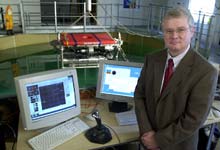This special field revolves around processes for modifying material properties (milling, cooling), composition (filtration, distillation) and type (oxidation, hydration).
Valuable information is available on a broad range of technologies including material separation, laser processes, measuring techniques and robot engineering in addition to testing methods and coating and materials analysis processes.

Russian scientists of the Kovrov State Technology Academy have proposed a new technology for aluminium alloy welding based on using of two lasers. The first laser removes the oxide film by small portions from the surface of welded components, and the second laser executes the welding. Although the first phase lasts for about one millionth of a second, it is very important, since the refractory oxide film deteriorates the welding strength. The new method is also characterized by one more benefit: the

Airplane wings or railway rails are examples of mechanical components constantly submitted to stress. They consist of materials (metal alloys) with properties that may change under stress. To understand and improve such materials, it is essential to observe them on a microscopic scale. The ESRF and the ILL make today a step forward into looking deep inside engineering components. Thanks to the use of complementary neutron and synchrotron X-ray beams, these two centres offer a unique tool to measure s

Tethered Robotic Sub Helps Engineers Refine Computerized Navigation, Control Systems
In a new indoor tank filled with almost 43,000 gallons of water, Johns Hopkins engineers are developing and testing computer control systems to serve as the “brains” for some of the world’s leading deep sea robotic exploration vehicles. To promote advances in underwater robotics, the Whiting School of Engineering recently constructed the circular hydrodynamics tank, 14 feet deep and 25 feet in diamet

A research team of the Public University of Navarre (Basque Country), under the supervision of professors Jesus Zurita Gabasa and Jesus Mª Pintor Borobia, from the department of Mechanical, Energetic and Materials Engineering, is working in a project to improve and optimise vibrating tables that are used in the agri-foodstuffs sector. The project is being done by the request of the company Tecnologia Alimentaria Urtasun from Navarre (Basque Country) , manufacturer of this kind of machinery.

Researchers at Oak Ridge National Laboratory are developing robotics technology that can aid in the cleanup of hazardous waste sites while helping to protect humans from serious injury in the process.
The telerobotic manipulation system enables cleanup efforts to be conducted remotely from a distant location, performing chores that would have to otherwise be done on site by humans.
Developed by the Department of Energy’s Robotics Crosscutting program, the system may be used in th

Phoning home from 93 billion miles away–only E.T. and other science fiction characters can do that. But with the help of National Institute of Standards and Technology (NIST) know-how, reality soon may catch up with imagination.
Conceptual designs for a “realistic interstellar explorer,” or RISE — a highly autonomous craft that would travel far beyond this solar system to collect scientific data — call for a laser-based communications link to Earth that relies in part on a recent NIST i